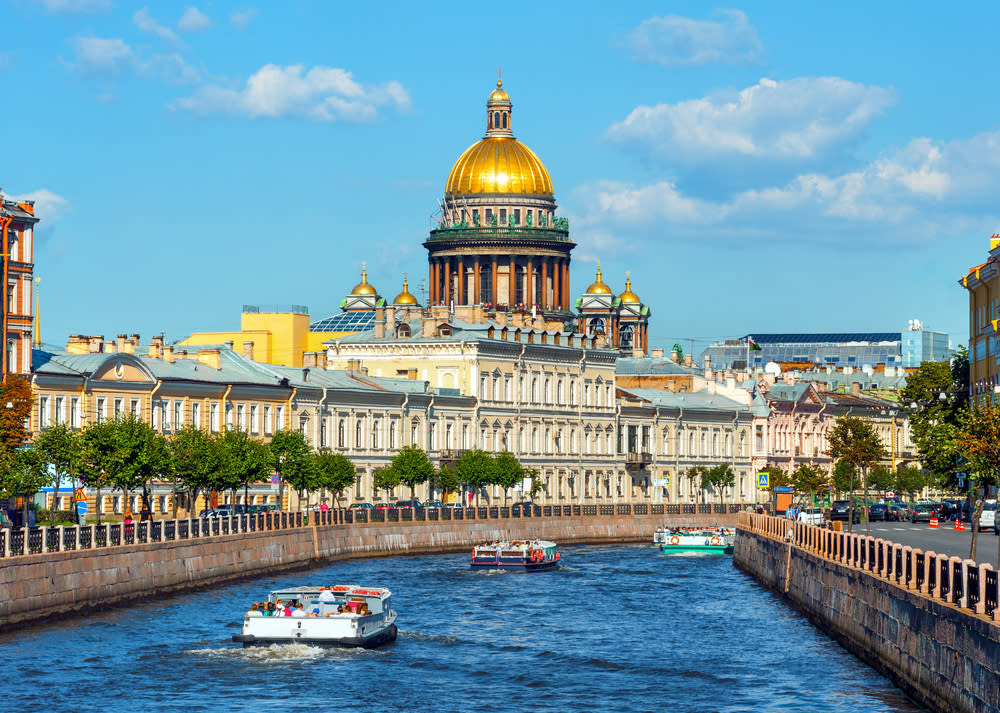More from St Petersburg
Main Menu
- 00:00
- 06:00
- 12:00
- 18:00
- 23:00
St Petersburg : Next 24-Hour Weather
Today - 25th April 2025
Sunrise 05:14
Sunset 20:42
Tomorrow - 26th April 2025
Sunrise 05:14
Sunset 20:42
Holiday Weather Now
Sorted by popularity:
Updated at 08:00 GMT
-
Temp feels like1°C34°F
-
Length of day15h 28m
-
Pressure29" (1014 hpa)
-
Visibility10 km (6miles)
-
Wind speed10 km/h
Sunrise 05:14
Sunset 20:42
-
Temp feels like:
1ºC (34 ºF)
-
Length of day:
15h 28m
-
Pressure:
29" (1014 hpa)
-
Visibility:
6 miles (10 km)
-
Wind speed:
10 km/h
Weather St Petersburg , Russia
St Petersburg has short, mild summers with long days, and long cold winters with short days. It has a humid continental climate which is heavily influenced by the Baltic Sea which reaches up towards the Arctic Circle. St Petersburgâs weather is known most for its changeability and its high level of cloud cover, with only 75 days of sunshine per year. St Petersburg is also prone to flooding. The city is in the north of westernmost Russia on Neva Bay which opens onto the Gulf of Finland, an arm of the Baltic Sea.
Summer St Petersburg
From June till August, is warm and quite wet. The average high temperature rises to 19°C in June, peaks at 23°C in July then drops to 21°C in August. Night time lows hover around 10°C so you always need an extra layer handy. The weather is highly unpredictable and changeable at all times so in the summer you might suddenly find yourself sweltering in 30°C heat or shivering in the cold rain. Summer sees the wettest weather of the year with rain falling on around half of the days in each month. The amount that falls is not particularly high but its frequency can be a bit annoying. You are unlikely to want to take a dip in the sea without a wetsuit which is warmest in August at an average temperature of 15°C. Sunshine levels are highest at the beginning of the season with an average of nine hours per day. This sounds very good but the figures are inflated by the fact that St Petersburg, being far north, has exceptionally long days and short nights in the summer. Daylight lasts for nineteen hours in June.
Autumn, in September and October, cools down quickly and is often very drizzly. The average high temperature drops to 14°C in September then 7°C in October. The average low plummets to 6°C and 1°C respectively. Frosts are common from the start of October and snow might start to fall at the end of the month. Sunshine levels dwindle dramatically as the days shorten and the clouds become more persistent. November sees on average four hours per day while October sees only two. Rainfall reduces in volume but actually falls even more often, on around seventeen days in each month â" a bit dismal.
Winter in St Petersburg
From November till March, is what St Petersburg is all about. If you are looking for snow and ice, St Petersburg is where itâs at. The average high drops below freezing for most of the season: 1°C in November, -3°C in December, -4°C in January, -5°C in February and 0°C in March. And if you thought that was bad, at night it really gets cold, lingering around -10°C for most of the season. Horses pulling sleighs... that really is possible here. Snow and ice cover everything . There are on average 123 days with snow cover during the winter and the average thickness is 24cm by February. Neva Bay freezes around late November or early December and does not break up till the beginning of spring. The average water temperature gets down to 0°C in February and March. Sunshine is minimal as daylight only lasts for a short period â" days are only six hours long in darkest December.
While most people choose to visit St Petersburg in the summer, winter here is beautiful and, for those who live in more temperate climates, a very interesting experience.
Spring,St Petersburg
in April and May, rapidly warms up and is usually quite dry. The average high temperature increases to 8°C in April and 14°C in May. The average low stays below freezing at -2°C in April, but gets up to 4°C in May. Neva Bay begins to thaw properly in April and snowfall tends to relent. Remember though that for most of April it still falls below freezing at night so any meltwater re-freezes â" sometimes creating treacherous conditions on the roads. The days lengthen and the sunshine levels jumps to six hours per day in April and six hours per day in May. Rainfall is low but light showers can be expected on around twelve days in each month. Neva Bay takes a long time to warm up, only reaching 4°C in May.
Flooding
Floods can occur at any time of year in St Petersburg and are quite unpredictable as they are not directly linked to rainfall or thawing in the surrounding areas. Low pressure over the far-off Atlantic creates âlong wavesâ that bring great volumes of water into the bay. This water is forced to flood the city as strong northerly winds trap it in the bay, not letting it flow back into the Gulf of Finland.

















